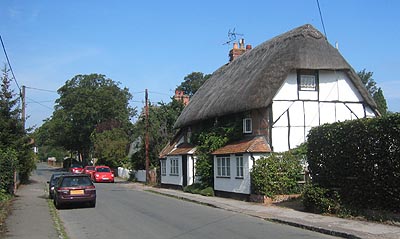 |
 |
|||
|
|
 South
Moreton South
MoretonWarriors & Weaponry The village name is Saxon and means what it says, 'Moor Town'. The marshy moorland was formed by the many riverlets running through this area and into the Thames. At the end of Church Lane, next to the Church stands a Norman Conquest castle. It remains as an irregular circular mound with a trench nearly all the way round and the Mill Brook acting as a moat. It may have never been finished, but was presumably intended for William Lovett who owned Sanderville Manor at Domesday (1086). Further north, surrounding the Manor House (alias Sanderville Manor) are the extensive remains of the moat of a siege castle of King Stephenís reign. In the 1150s, the King was busy trying to prevent his cousin, the Empress Matilda, from appropriating his throne. During a fierce Civil War, the Empressí main HQ was at Wallingford Castle and Moreton Castle is thought to have been one of three built to keep her forces in check. The manor itself seems to have been built by Neil de Sanderville about a hundred years later. The west wing of this structure survives. The east wing was added by his son, Thomas, after having received a windfall in tenant entry fines, in 1326. His son, also Thomas, rebuilt the hall in the early 1340s and added an oratory in 1344. There were three other manors in the parish. The site of Fulscot Manor also has a moat, but it only survives on the western side. The parish church, dedicated to St. John the Baptist, is mostly 13th and 14th century, though there are clear remains of a Saxon west door. Outside, the old yew tree is said to have been used to store the localsí bows and arrows during church services. From medieval times, they were obliged to practice archery in order to supplement the army recruits. Some who failed to do so were fined in 1628. A mound near the church is said to be a burial mound for those who fell during the Civil War. On the war memorial appears the name of Peter Belloc, son of the French-born writer, Hilaire Belloc, both of whom lived in the village. Industry in South Moreton has always been largely based on agriculture, particularly sheep farming. The local farmers used to drive all their flocks into the Tibbald Brook, on the parish boundary, for dipping. There were both paper and corn mills, one of which is mentioned in the Domesday Survey (1086). The latter's mill house was used as a hospital during a smallpox epidemic in 1799! Unfortunately the mill was burnt down in 1825. The village stocks used to stand at Cross Tree, where Manor Lane meets the main village street. Perhaps the two Parkes brothers were frequent occupants in the early 19th century. They certainly seem to have had a knack of getting themselves into trouble. An old village story tells how, in order to see a multi-clerical exorcism, they crept into a barn in the village which had been much troubled by the unquiet spirit of a suicide. The phantom appeared and asked for the two mice under the straw. Luckily, the clergy offered the cock on the dunghill instead!
|
|||
| © Nash Ford Publishing 2004. All Rights Reserved. This location is now administered by Oxfordshire County Council. | ||||


